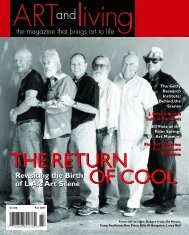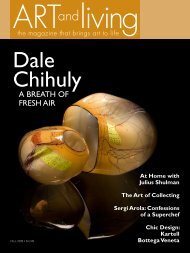Ed Ruscha Ed Ruscha Ed Ruscha - Art and Living
Ed Ruscha Ed Ruscha Ed Ruscha - Art and Living
Ed Ruscha Ed Ruscha Ed Ruscha - Art and Living
- No tags were found...
Create successful ePaper yourself
Turn your PDF publications into a flip-book with our unique Google optimized e-Paper software.
is an unprecedented experiment which tries to go beyond Impressionism to pushit to its limits. In fact, it is the culmination of his approach, of his work on series.”Unveiled a year after the painter’s death, the paintings initially failed to attracta public that saw Impressionism as outdated. By the 1960s, when architects addeda second floor to the museum to house the Walter-Guillaume collection—includingworks by Renoir, Picasso <strong>and</strong> Modigliani—the skylight above the water lilies wassealed off, depriving them of natural light <strong>and</strong> their original, intended stage.With Impressionism back in vogue by the 1980s, visitors flocked to theOrangerie in numbers that would reach some 500,000 per year. In spite of—or perhapsbecause of—the vast numbers of people visiting the museum, it was decidedthat the 1960s-created space simply didn’t do justice to Monet’s panels <strong>and</strong> themuseum was closed in 2000 for the extensive renovations that would return sunlightto the Nymphéas.Since the water lilies could not be detached from the walls, they were sealedinside protective casings <strong>and</strong> left in the midst of the renovations, managing toemerge intact despite playing neighbor to jackhammers <strong>and</strong> earth-movers for halfa decade.The top floor was demolished <strong>and</strong> the Walter-Guillaume collection movedto a new basement gallery, where some paintings hang on exposed concrete walls.The small vestibule leading to the water lilies, which had been destroyed in the1960s, has been restored.“Monet explicitly conceived this as a transitional space, a sort of vestibule, likein a temple or a church,” says Saunier.If Monet was feeling mystical, it was largely due to the context of the FirstWorld War, which was raging around him as he began work on the series.“When he was painting these canvases, he had the feeling he was fighting forthe values of beauty in the face of barbarity,” says Saunier.Now, this ardent celebration of nature can once more be viewed in its full splendor.“We had to give justice to Monet <strong>and</strong> I think we succeeded,” Saunier says witha satisfied smile. Joelle DiderichJohn Singer Sargent, Madame X, 1884. Oil on canvas. Permanent collection,Metropolitan Museum of <strong>Art</strong>, New York. Image courtesy the MetropolitanMuseum of <strong>Art</strong>.Ongoing • Jardin des Tuileries, Paris, France33.01.44.77.80.07 • www.musee-orangerie.frAmericans In Paris, 1860-1900The Metropolitan Museum of <strong>Art</strong>, New York, New YorkThe year: 1884.The sc<strong>and</strong>al: John Singer Sargent’s Madame X, a painting ofNew Orleans belle Virginie Avegno, who had recently crashed the Parisiansocial scene with her marriage to Pierre Gautreau.The American artist’s fulllengthcanvas—showing Virginie in a figure-revealing, low-cut black gown—had onethin, jeweled strap falling provocatively over her bare right shoulder.The public was outragedat the risqué image <strong>and</strong>, although Sargent retouched the painting so that bothstraps rested firmly in place, the damage was done. Sargent feared that no one inFrance would commission him to do another portrait <strong>and</strong>, reluctantly, he departed forLondon.The painting, which he called “the best thing I have ever done,” stayed in hispossession until 1916, when New York’s Metropolitan Museum of <strong>Art</strong> purchased it.Sargent’s infamous Madame X is one of approximately 100 oil paintings by37 artists in the Americans in Paris, 1860-1900 exhibition at the MetropolitanMuseum of <strong>Art</strong>, on display from October 24th through January 28th. It’s the finalstop in a three-city tour that included the National Gallery, London, <strong>and</strong> TheMuseum of Fine <strong>Art</strong>s, Boston.<strong>Art</strong> <strong>and</strong> <strong>Living</strong> 13






